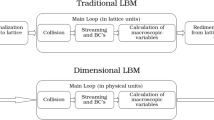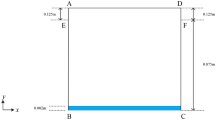Abstract
A well-posed mathematical model of non-isothermal two-phase two-velocity flow of bubbly liquid is proposed. The model is based on the two-phase Euler equations with the introduction of an additional pressure at the gas bubble surface, which ensures the well-posedness of the Cauchy problem for a system of governing equations with homogeneous initial conditions, and the Rayleigh–Plesset equation for radial pulsations of gas bubbles. The applicability conditions of the model are formulated. The model is validated by comparing one-dimensional calculations of shock wave propagation in liquids with gas bubbles with a gas volume fraction of 0.005–0.3 with experimental data. The model is shown to provide satisfactory results for the shock propagation velocity, pressure profiles, and the shock-induced motion of the bubbly liquid column.














Similar content being viewed by others
References
Frolov, S.M., Frolov, F.S., Aksenov,V.S., Avdeev, K.A., Petrov, A.D.: Pump-jet pulse detonation engine (variants) and method for creating hydro-jet thrust. Patent application PCT/RU2013/001148 on 23.12.2013. https://patentscope.wipo.int/search/ru/detail.jsf?docId=WO2015099552. Accessed 2 July 2015
Avdeev, K.A., Aksenov, V.S., Borisov, A.A., Tukhvatullina, R.R., Frolov, S.M., Frolov, F.S.: Numerical simulation of momentum transfer from a shock wave to a bubbly medium. Russ. J. Phys. Chem. B 9(3), 363–374 (2015). doi:10.1134/S1990793115030021
Wijngaarden, L.V.: On equations of motion for mixtures of liquid and gas bubbles. J. Fluid Mech. 33(3), 465–474 (1968). doi:10.1017/S002211206800145X
Kutateladze, S.S., Nakoryakov, V.E.: Heat and Mass Transfer and Waves in Gas–Liquid Systems. Izdatel’stvo Nauka, Novosibirsk (1984)
Kameda, M., Matsumoto, Y.: Shock waves in a liquid containing small gas bubbles. Phys. Fluid 8(2), 322–335 (1996). doi:10.1063/1.868788
Kameda, M., Shimaura, N., Higashino, F., Matsumoto, Y.: Shock waves in a uniform bubbly flow. Phys. Fluid 10(10), 2661–2668 (1998). doi:10.1063/1.869779
Mori, J., Hijikata, K., Komine, A.: Propagation of pressure waves in two-phase flow. Int. J. Multiph. Flow 2(2), 139–152 (1975). doi:10.1016/0301-9322(75)90004-X
Sychev, A.I.: Intense shock waves in bubble media. Tech. Phys. 55(6), 783–788 (2010). doi:10.1134/S1063784210060058
Nakoryakov, V.E., Pokusaev, B.G., Shreiber, I.R., Kuznetsov, V.V., Malykh, N.V.: Wave processes in two-phase systems. In: Kutateladze, S.S. (ed.) Inst. Therm. Phys. Sib. Br. USSR Academy of Sciences, p 54. (1975)
Borisov, A.A., Gelfand, B.E., Timofeev, E.I.: Shock waves in liquids containing gas bubbles. Int. J. Multiph. Flow 9(5), 531–543 (1983) doi:10.1016/0301-9322(83)90016-2
Gelfand, B.E., Gubin, S.A., Kogarko, B.S., Kogarko, S.M.: Investigations of compression waves in a mixture of liquid with gas bubbles. Doklady USSR Acad. Sci., 213, No.5. (1973)
Avdeev, K.A., Aksenov, V.S., Borisov, A.A., Frolov, S.M., Frolov, F.S., Shamshin, I.O.: Momentum transfer from a shock wave to a bubbly liquid. Russ. J. Phys. Chem. B 9(6), 895–900 (2015). doi:10.1134/S1990793115060032
Nigmatulin, R.I.: Dynamics of Multiphase Media, vol. 1. Hemisphere, New York (1990)
Preston, A.T., Colonius, T., Brennen, C.E.: A reduced-order model of diffusive effects on the dynamics of bubbles. Phys. Fluid 19(12), 123302 (2007). doi:10.1063/1.2825018
Gidaspow, D.: Modeling of two phase flow. Heat transfer 7, 163–168 (1974)
van Wijngaarden, L.: Some problems in the formulation of the equations for gas/liquid flows. In: Koiter, W.T. (ed.) Theoretical and Applied Mechanics. North-Holland Publishing Company, Amsterdam, pp. 249–260 (1976)
Stewart, H.B.: Stability of two-phase flow calculation using two-fluid models. J. Comput. Phys. 33(2), 259–270 (1979). doi:10.1016/0021-9991(79)90020-2
Klebanov, L.A., Kroshilin, A.E., Nigmatulin, B.I., Nigmatulin, R.I.: On the hyperbolicity, stability and correctness of the Cauchy problem for the system of equations of two-speed motion of two-phase media. J. Appl. Math. Mech. 46(1), 66–74 (1982). doi:10.1016/0021-8928(82)90084-3
Ramshaw, J.D., Trapp, J.A.: Characteristics, stability, and short-wavelength phenomena in two-phase flow equation systems. Nucl. Sci. Eng. 66(1), 93–102 (1978)
Radvogin, YuB, Posvyanskii, V.S., Frolov, S.M.: Stability of 2D two-phase reactive flows. J. Phys. IV 12, 437–444 (2002). doi:10.1051/jp4:20020313
Stuhmiller, J.H.: The influence of interfacial pressure forces on the character of two-phase flow model equations. Int. J. Multiph. Flow 3(6), 551–560 (1977). doi:10.1016/0301-9322(77)90029-5
Yeom, G.S., Chang, K.S., Baek, S.W.: Robust Waf-Hll scheme for compressible two-pressure two-velocity multiphase flow model. Eng. Appl. Comput. Fluid Mech. 6(1), 144–162 (2012). doi:10.1080/19942060.2012.11015410
Yeom, G.S., Chang, K.S.: Two-dimensional two-fluid two-phase flow simulation using an approximate Jacobian matrix for HLL scheme. Numer. Heat Transf. Part B Fundam. 56(5), 372–392 (2010). doi:10.1080/10407790903507998
Gavrilyuk, S., Saurel, R.: Mathematical and numerical modeling of two-phase compressible flows with micro-inertia. J. Comput. Phys. 175(1), 326–360 (2002). doi:10.1006/jcph.2001.6951
Burdukov, A.P., Kuznetsov, V.V., Kutateladze, S.S., Nakoryakov, V.E., Pokusaev, B.G., Shreiber, I.R.: Shock wave in a gas–liquid medium. J. Appl. Mech. Tech. Phys. 14(3), 349–352 (1973). doi:10.1007/BF00850948
Noordzij, L. Shock waves in bubble–liquid mixtures. Phys. Communs 3 (1971)
Plesset, M.S., Prosperetti, A.: Bubble dynamics and cavitation. Annu. Rev. Fluid Mech. 9, 145–185 (1977). doi:10.1146/annurev.fl.09.010177.001045
Schlichting, H.: Boundary-Layer Theory. McGraw-Hill, New-York (1968). doi:10.1007/978-3-662-52919-5
Lamb, H.: Hydrodynamics. Cambridge University Press, Cambridge (1932)
Clift, R., Grace, J.R., Weber, M.E.: Bubbles, Drops, and Particles. Courier Corporation, New York (2005)
Harlow, F.H., Amsden, A.A.: A numerical fluid dynamics calculation method for all flow speeds. J. Comput. Phys. 8(2), 197–213 (1971). doi:10.1016/0021-9991(71)90002-7
Zel’dovich, Y.B., Raizer, Y.P.: Physics of Shock Waves and High-Temperature Hydrodynamic Phenomena. Dover Publications, New York (2002)
Acknowledgements
The present authors would like to thank their colleagues V.S. Aksenov, K.A. Avdeev, F.S. Frolov, I.O. Shamshin, and I. A. Sadykov for their valuable contribution to the experimental results used in this article. This work was supported by the Russian Foundation for Basic Research (project ofi-m 16-29-01065).
Author information
Authors and Affiliations
Corresponding author
Additional information
Communicated by F. Zhang and A. Higgins.
Appendix
Appendix
where \(p^0 = p^0_2 = p^0_1\), \(p^0_{\mathrm {i}} = p^0 + C_\mathrm {s}(\phi ^0_2, \mathrm {Re}_{12}^0) \rho _1 (u^0_1 - u^0_2)^2\), \(\displaystyle {R^0 = \left( \frac{3 \phi ^0_2}{4 \pi N}\right) ^{\frac{1}{3}}}\). For matrix Q there are no zero elements only for \(\displaystyle {Q_{7,2} = - \frac{1}{\rho _1 R^0}}, \displaystyle {Q_{7,3} = \frac{1}{\rho _1 R^0}}, Q_{6, 7} = - 4\pi N \left( R^0\right) ^2\).
The polynomials are written in the following form using the relations \(c^2_2 \rho _2 = p_2 \gamma \) and (2):
where \(\displaystyle {\varkappa = \frac{3 \phi ^0_2}{(R^0\beta )^2\rho _1}}\)

Rights and permissions
About this article
Cite this article
Tukhvatullina, R.R., Frolov, S.M. Well-posed Euler model of shock-induced two-phase flow in bubbly liquid. Shock Waves 28, 253–266 (2018). https://doi.org/10.1007/s00193-017-0731-y
Received:
Revised:
Accepted:
Published:
Issue Date:
DOI: https://doi.org/10.1007/s00193-017-0731-y




